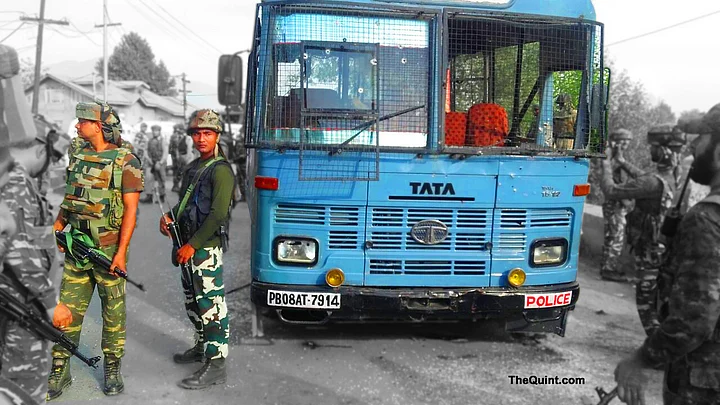Here’s another angle to the attack on the CRPF bus proceeding from Pampore to Bijbehara last Saturday. Let’s begin with the location itself:
CRPF briefings suggest that this 35-km stretch is a sensitive area where the terrain lends itself to attack of the kind that took place. That is true. But six years ago, when the then UPA government took the decision to reduce the army’s profile in the public eye, this was one of the areas identified for CRPF deployment as the threat component had come down.
The grapevine has it that the CRPF had only two conditions for taking over security duties at that time:
- That the area in question should not be “threatened” (meaning it
should be free of terrorists) and,
- It should be “logistically” convenient, meaning there should
be sufficient built-up area to accommodate their personnel.
Were CRPF Personnel Unarmed?
Now let’s look at the two videos of the attack, one by a civilian living across the road, and another shot by the army.
The first video shows the CRPF bus stationary on the road with the sound of gunfire echoing. There is no other vehicle either in front of the bus or behind it, which is odd because standard operating procedure dictates a certain number of vehicles in a convoy. The video does not suggest there was any return fire from within the bus which is again odd because there were, according to media reports, at least 40 armed jawans sitting inside.
The other video of the attack has been taken from the wired window of an RR (Rashtriya Rifles) Casspir (mine-proof) armoured vehicle. There is a point when a lot of smoke passes before the camera, indicating army personnel firing back at the terrorists.
An armoured CRPF vehicle is parked in front and on the right of the bus but it’s hard to tell if anybody in the bus fires at the terrorists. The video informs us that the CRPF jawans in the armoured vehicle fired at the terrorists but it’s not clear if this indeed did happen.
Army Defended CRPF Personnel
At one point, the CRPF deputy commandant’s armoured gypsy draws up, some words are exchanged with the men inside the CRPF vehicle. It’s not clear if the deputy commandant is inside, but certainly nobody gets out.
The final sequence now plays out. There is more firing, the army Casspir moves forward and then we see personnel, whom the video identifies as “CRPF personnel”, close in on foot on the bus. But they are not coming from the direction of the CRPF armoured vehicle. In fact, a closer examination shows that they are not CRPF constables but army troopers. Their bulletproof patkas (head gears) are distinctive, something the CRPF never wears, which suggests an army presence in front of the bus not visible in the video.
Conflicting Theories
- CRPF had taken over the area
in Pampore six years ago on the condition it should not have terrorist presence, though now the force admits it’s a sensitive zone.
- Videos of the incident suggest there was no return fire from the bus, which raises questions whether the CRPF jawans were adequately armed.
- Presence of head
gear the army usually wears suggests presence of armymen who supposedly came to defend the CRPF jawans.
- Reports suggest CRPF men were hit by INSAS and not AK-47 bullets, which indicates CRPF troopers shot their own in
confusion as INSAS rifles are issued to them.
- Army and the CRPF are not on
the same page on the number of terrorists involved in the attack.
Mystery Around INSAS Rifle Bullets
There are other points. The CRPF claims its men fired on the terrorists from inside the bus. This is hard to verify from the video. But it’s clear that the two terrorists were so close to the bus that it may have been difficult for the men inside to get an angle on them. The singular lack of any action by the men inside the bus raises the question how the CRPF trains its people to handle such eventualities.
Odder still, reports from Srinagar say some of the constables had been injured by INSAS rifle bullets, not the AK-47s the terrorists were armed with. Did the constables end up shooting each other in the panic that ensued? Were the shots fired from the CRPF vehicle outside?
The CRPF is armed with INSAS, the army’s RR unit had Kalashnikov rifles which are standard issue for counter-insurgency duties.
The CRPF brass is on record saying there were only two terrorists, but the army suspects there may have been at least four, two of whom escaped. Nalin Prabhat, the CRPF IG who came on the scene, is the same officer who was transferred out of Dantewada in May 2010, following the massacre of 80 jawans by Maoists. The EN Rammohan Committee which probed the incident cited “command failure” but it would seem Prabhat got off.
CRPF Officer’s Questionable Conduct
After the smoke and fire cleared, it was apparently Prabhat who insisted that the incident be termed a “joint operation” with the army. If one goes back to the Dantewada massacre, the same word-play is evident.
From the above, it is clear the CRPF needs to do some honest soul searching about the training and tactics employed in places like J&K. The force is also bereft of leadership, with the fighting and dying confined to constables and head constables. The officers seem to be doing only administrative duties. The conduct of the deputy commandant in the armoured Gypsy is illustrative. Such conduct in the army would have amounted to cowardice.
(Surya Gangadharan is former international affairs editor, CNN-IBN and NDTV. He can be reached at @suryagang)
Also read:
After Massacre of CRPF Men, Time to Tighten Counter-Terror Tactics
